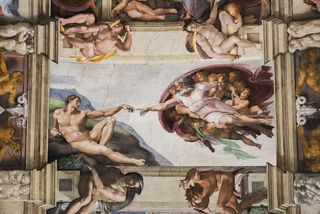
Sistine Chapel Photo Project Is So Detailed It Shows Individual Brushstrokes

After spending five years collecting 270,000 digital frames, researchers have photographed every nook and cranny of the Sistine Chapel for a massive collection of photographs that will be used to help preserve and restore the historic site, according to news reports.
Decades after the entire Sistine Chapel was last photographed, when digital photography was in its infancy, the building has now been re-created pixel by pixel in a collection of photographs, Reutersreported. Everything from Michelangelo's famous frescoes to the chapel's mosaic floor has been photographed in fine detail, which will be used to aid future restoration projects, according to Reuters.
"In the future, this will allow us to know the state of every centimeter of the chapel as it is today, in 2017," Antonio Paolucci, former head of the Vatican Museums, told Reuters. [Gallery: Hidden Gems in Renaissance Art]
Beyond being used by the Vatican Museums for restoration projects, the photographs will be printed in a three-volume, 870-page set. According to Reuters, the set was created by the Vatican Museums and Italian high-end art publisher Scripta Maneant. With a limited 1,999-copy printing, the set will cost about $12,700 (12,000 euros) and will be marketed to libraries and collectors, Reuters reported.
The team of photographers used special telescopic lenses to capture the detail needed for the complete photographic record of the Sistine Chapel, which amounted to 30 terabytes of information. For comparison, 30TB of data could hold approximately 510,000 hours of music, based on calculations by Kelly Brown, an assistant professor and academic director of the Applied Information Management program at the University of Oregon. Photographers also used 33-foot-high (10 meters) portable scaffolding to reach artistic details such as the chapel's famous ceiling frescoes painted by Michelangelo, according to Reuters.
The resulting photographs are so detailed that brushstrokes are clearly visible, Reuters reported.
"We used special post-production software to get the depth, intensity, warmth and nuance of colors to an accuracy of 99.9 percent," Giorgio Armaroli, head of Scripta Maneant, told Reuters. "Future restorers will use these as their standards."
Sign up for the Live Science daily newsletter now
Get the world’s most fascinating discoveries delivered straight to your inbox.
Original article on Live Science.

Most Popular


